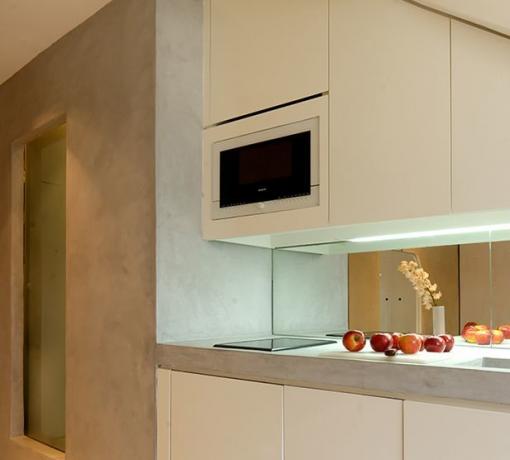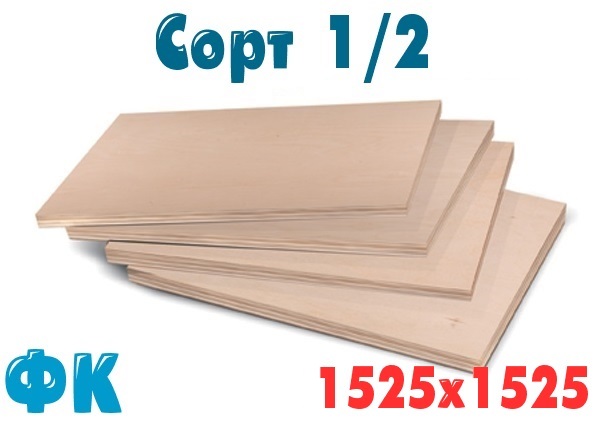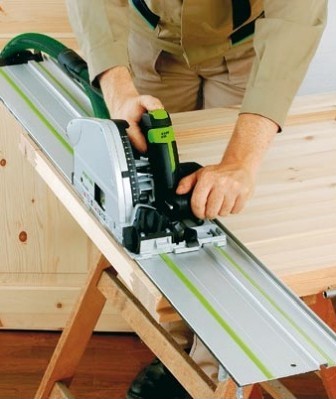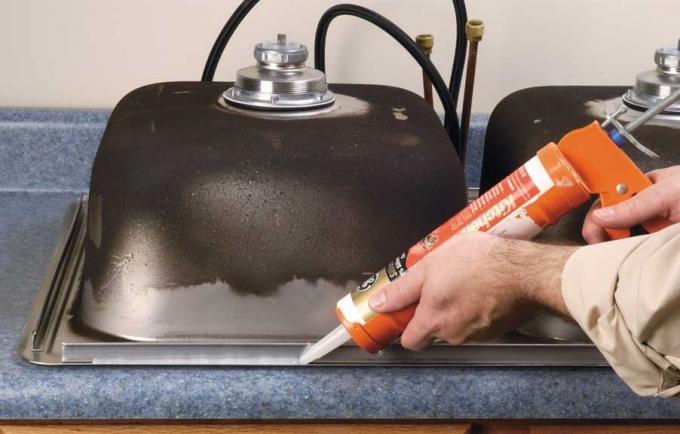Content
-
1 Sorts, types and standard sizes of plywood
- 1.1 Plywood classification
- 1.2 Plywood typical dimensions
-
2 Design and manufacture of kitchen units
- 2.1 Design, kitchen dimensions
- 2.2 Materials, fittings and tools
- 2.3 A set of tools for assembling a kitchen set from plywood
- 2.4 Assembly and processing of plywood kitchen units
- 3 conclusions
An interesting fact - most domestic furniture manufacturers do not make kitchens out of plywood. This can be easily confirmed if you call companies that make custom-made furniture. In the best case, they will tell you that they do not work with this material specifically, but "any whims for your money."
Others - will begin to convince to order a kitchen set made of plastic, MDF, chipboard, chipboard, solid wood, they will frighten that plywood swells from moisture in the kitchen, it will lead it.

Photo: plywood kitchen in a Parisian attic
But, then I wonder why in the USA, in the EU countries, plywood is widely used in production of kitchen furniture (it is worth going to an IKEA store). Probably, the main reason is that you still have to look for it in order to choose high-quality plywood, to deal more with its finishing, processing during the assembly process. Why do furniture makers need extra trouble ?!
This is where a constructive idea appears, to make a kitchen out of this material yourself.
Moreover, plywood has certain advantages:
- Its environmental friendliness is better than that of chipboard, MDF, fiberboard
- It is more stable, holds threaded fasteners more firmly, more wear-resistant in the attachment points.
It is useful to watch the video for comparing materials.
Sorts, types and standard sizes of plywood
A large amount of plywood is produced in Russia. It is also imported from abroad, for example, Finland, China (not the best option). Plywood is a layer of peeled veneer tightly glued together.
Products from birch and coniferous tree species are widely represented (coniferous plywood is less durable, but the price is lower). There are samples of beech, mahogany varieties, tropical trees.
In order to correctly purchase the plywood we need, we need to deal with the classification of this material.
Details of this information are given in the documents:
- GOST 3916.1-96 "General purpose plywood with outer layers of hardwood veneer".
- GOST 3916.2-96 "General purpose plywood with outer layers of coniferous veneer".
Let us choose from these standards a piece of information that will help us navigate when choosing it in stores (at bases) of building materials.
Plywood classification

Appearance of different varieties
- By grade - depends on the appearance of the surface (E - extra grade, I, II, III, IV). The grade of plywood is designated as "face grade / back grade" (1/1, 1/2, 2/2, etc.).
- By brand - characterizes the water resistance of the adhesive joint (FSF, FC, FKM, FBA).
- It is divided according to the degree of surface treatment - polished and not polished (NSh - not polished, W 1 - polished on one side, W 2 - polished on both sides).
- For environmental safety - for the content of formaldehyde (E 1, E 2, E 3).
Advice!
For the content of harmful substances in various materials and methods for their reduction, it is useful to read the book by A.E. Anokhin "Reducing the toxicity of furniture."
Plywood typical dimensions
- FC: 1525x1525, 1500x1500 mm, thickness 3, 4, 6, 8, 9, 10, 12, 15, 18, 21, 24, 27, 30 mm.
- FKM: 1220x2440 mm, 1250x2500 mm, 1525x3050 mm, thickness 3, 4, 6, 8, 9, 10, 12, 15, 18, 21, 24, 27, 30 mm.
- FSF: 1220x2440 mm, 1250x2500 mm, 1525x3050, 1525x1525 mm, thickness 4, 6, 8, 9, 10, 12, 15, 18, 21, 24, 27, 30 mm.
- Typical dimensions of film faced plywood: 1220x2440 mm, 1250x2500 mm, 1500x3000 mm, thickness 4, 6, 9, 12, 15, 18, 21, 24, 27, 30 mm.
In a specific case, we choose plywood for the kitchen - FC (moisture resistant plywood, on urea glues), grade 1/2, with thicknesses of 18, 12 and 6 mm.

For the kitchen we chose plywood FC, grade 1/2
Advice!
You should not waste time and money looking for only Finnish plywood (for example, the Finnish concern UPM or other "foreigners").
Now samples of Russian manufacturers, which are produced on the same machines and lines, are often not inferior to foreign positions using similar technology.
Design and manufacture of kitchen units

Kitchen made of plywood without surface finishing
Design, kitchen dimensions
Front assembly of kitchen furniture it is necessary to first make measurements at the place of installation of kitchen furniture and a drawing, a project of its construction (sketch). This can be done manually or with a computer using 3D software products - modeling (SketchUp, PRO100, Astra Furniture Designer, Basis Furniture Designer, bCad- Furniture maker and others).
Based on measurements of the place where the furniture structure will be installed, we plan dimensions of kitchen furniture.
Adhering to the accepted standards, we determine the dimensions of the floor cabinets:
- height - 85 cm (considering the thickness of the table top);
- depth - 45 (50) cm;
- width - 60 (80) cm with swing doors (including a cabinet under the sink), or 30 (40) cm with pull-out drawers.
Wall cabinets:
- height - about 70 cm (a little more, depending on the height of the ceiling of the kitchen);
- depth - 30 cm;
- width - adjust to the selected width of the base cabinets.
When choosing a distance between wall and base cabinets, we adhere to a size of 45 - 65 (cm).
These dimensions are guidelines only. But, of course, it all depends on the growth and desire of the hostess, the characteristics and geometry of the kitchen space..
We add all the selected dimensions to the sketch. We calculate the entire length of the kitchen furniture, taking into account the built-in appliances. We decide on the number and types of boxes, doors in the headset. Hollow doors are made of thin plywood with stiffening ribs inside (you can replace them with glass, mirror, plastic)
Important!
We calculate the standard sizes of each box, door and their component parts separately.
In the drawing, each cabinet is divided into drawers and doors, which must also have the stated dimensions.

Headset sketch is one example
The length of the shelves in cabinets, the frame of which is made of 18 mm thick FC plywood, is calculated as the difference between the width of the cabinet and the two thicknesses of the frame walls (36 mm).
Materials, fittings and tools
- Having all the dimensions of the cabinet and its components, it is necessary to choose the type of connection of the plywood frame (grooved, spike).
- Decide on fasteners (glues, nails, screws, confirmations, minifixes).
- Select fittings (handles, hinges, door closers) that will be used during assembly.
Now we have all sizes of cutting of plywood sheets, for drawing up an estimate of the necessary materials.
Advice!
It will be the best solution, the process of sawing large-sized plywood sheets and milling holes for door hinges according to sketches will be entrusted to specialists who have programmed machines.
Check the finished kitchen components for defects on the sawn and milled surfaces.
They can also help with marking selected parts on plywood blanks.

Sawing material with a plunge saw with your own hands
But, if you have the appropriate skills and a good plunge-cut saw, such as Festool or similar (with a special guide for cutting sheet materials), for the sake of economy, you can cut everything with your own hands, make markings on the back and front of the blanks from plywood.
A set of tools for assembling a kitchen set from plywood
- Marking and measuring tools - tape measure P - 3, folding rule, ruler, square, compass, thickness gauge.
- Saws - plunge-cut saw with a guide, cross-cut saw, jigsaw.
- Drilling tool - electric drill, a set of conventional and special drills (for furniture screed) and countersinks.
- Chiseling and planing tools - chisels, chisels, planers, mallet.
- Auxiliary tools - hammer, pliers, screwdrivers (cordless screwdriver), files, needle files, knives.
It is clear that in the presence of ready-made plywood blanks (walls, doors, tabletops), some tool is not needed (for example, a plunge-cut saw). A hacksaw will also be used minimally, for example, for sawing wooden blocks for stiffeners, if our choice is hollow plywood doors.
Assembly and processing of plywood kitchen units
Instructions and procedures for assembling and screed finished plywood blanks are not difficult.
We will fasten floor and wall cabinets:
- "Euroscrews" (confirmations) in the invisible part of the joints of plywood blanks, cabinets with each other (although they can also be used on the front side of plywood, after closing with decorative or self-adhesive overlays).

Confirmate - one-piece screed for plywood blanks
For a reliable and strong connection of plywood sheets using a confirmat (7 mm in diameter), we drill two holes (for its threaded and non-threaded part) with different diameters (5 mm and 8 mm). We countersink the drilled hole on the front side of the plywood frame blank for the confirmation head.
Advice!
It is best to do all the drilling and countersinking operations at one time using a special step drill.

Step drill, with which we make holes and countersinks in plywood blanks
When joining frame plywood blanks with a confirmatum, for the stability of plywood blanks, dowels (wood or plastic) can be additionally used. In the corners, to improve the rigidity of the plywood frame, you can use corners with a foot.

Docking of horizontal and vertical plywood blanks
- With "eccentrics" (minifixes) we pull together those joints of sheets of blanks that are visually visible.

Eccentric three-piece screed for kitchen plywood blanks
Where fasteners should not be visible on the front of the kitchen made of plywood, we use an eccentric coupler (minifix).
Advantages of screed kitchen plywood blanks with minifix:
- Reliable fasteners - fittings, will allow you to repeatedly assemble and disassemble the kitchen, without losing the quality of the docking.
- Minifixes will not be visible from the front of the kitchen, there is no need for decorative plugs.
- Installed eccentrics do not require special keys, tools, a flat screwdriver to assemble the kitchen.
If, when cutting plywood, you did not order marking, drilling and milling of holes for elements eccentric couplers (an eccentric made of metal, a plastic sleeve and a rod), it is easy to make them your own hands.
For this you need:
- Milling cutter (diameter 15-16 mm).
- Drills (7 and 10 mm in diameter).

Plywood screed with eccentric fasteners
Eccentric installation procedure:
- We make markings on the surface of the plywood, where there will be holes for the eccentrics. Kern the markup for the minifix coupling.
- In the plane of the plywood blank, we drill a blind hole (with a 10 mm drill) for a plastic sleeve.
- We install it (it is possible for strength on PVA glue, B3).
- We twist the minifix rod into the sleeve.
- We drill a blind hole (14 mm deep) for a metal eccentric in the mating plywood blank.
- Drill a hole at the end of the workpiece for the minifix rod. We drill it so that the rod goes into the eccentric hole.
A video will help you in more detail on the installation of an eccentric screed.
Thus, the kitchen frame is pulled together from plywood blanks, it remains only to mount the shelves and hang the doors.

Plywood shelves and kitchen doors

Hollow plywood hinged doors are hung with overhead hinges
The doors can be hinged using BLUM hinges with integrated door closers. In some places, the shelves can also be replaced with self-built built-in drawers.
The processing of plywood kitchen facades can be done by applying a decorative stain of any color (for example, from the Sayerlack product line) and covering it with oil - Borma wax or its analogues. Especially carefully, in several layers, it is necessary to process the ends of 18 mm plywood.
Advice!
Remember that after varnishing the surface of a plywood kitchen, if it is damaged, it is much more difficult and more expensive to fix the defect than if it is coated with oil and wax.

Oils and waxes for plywood facades
It is advisable to protect the plywood tabletop with an acrylic coating or marbled material. The countertop can be made by yourself, for example, using mixtures for a self-leveling floor with the addition of marble chips (metal strips are overlays, here they will play the role of formwork).
conclusions
Having made the decision to assemble a kitchen out of plywood, part of the work that requires accurate cutting, clear and correct marking, drilling for furniture fasteners is better to entrust to specialists of firms - professionally with this engaged. Then the assembly of plywood blanks will be much easier. Happy build!


